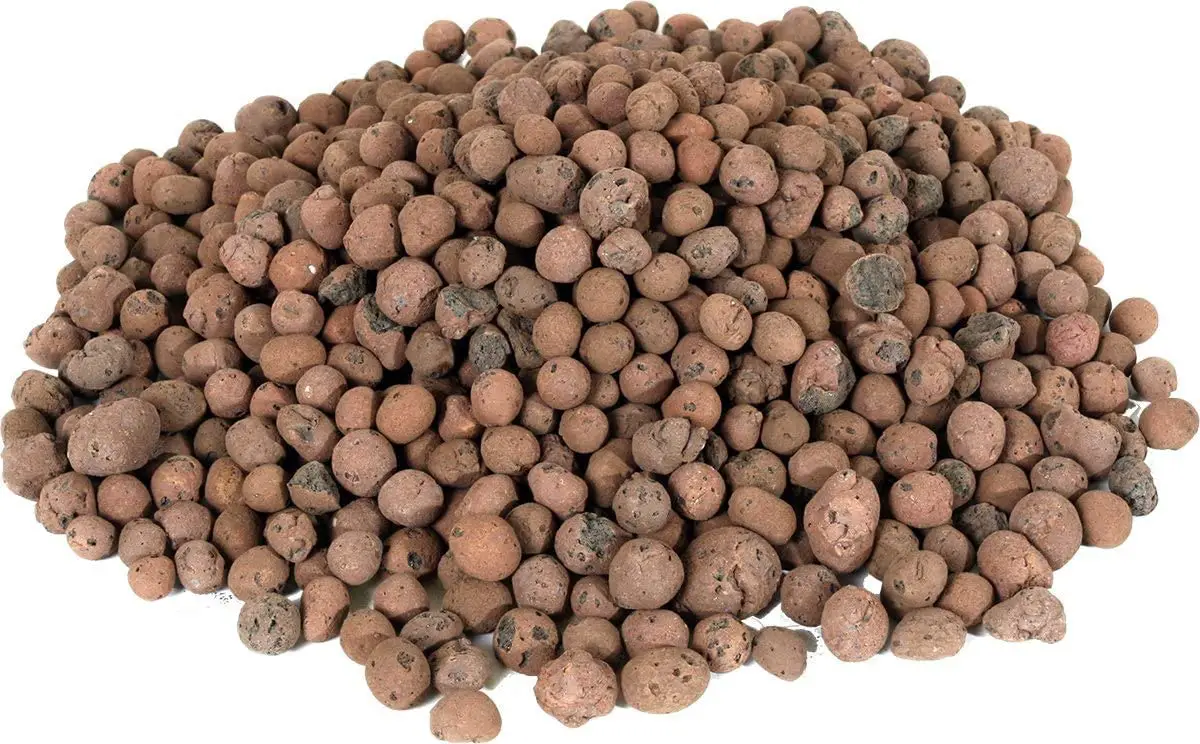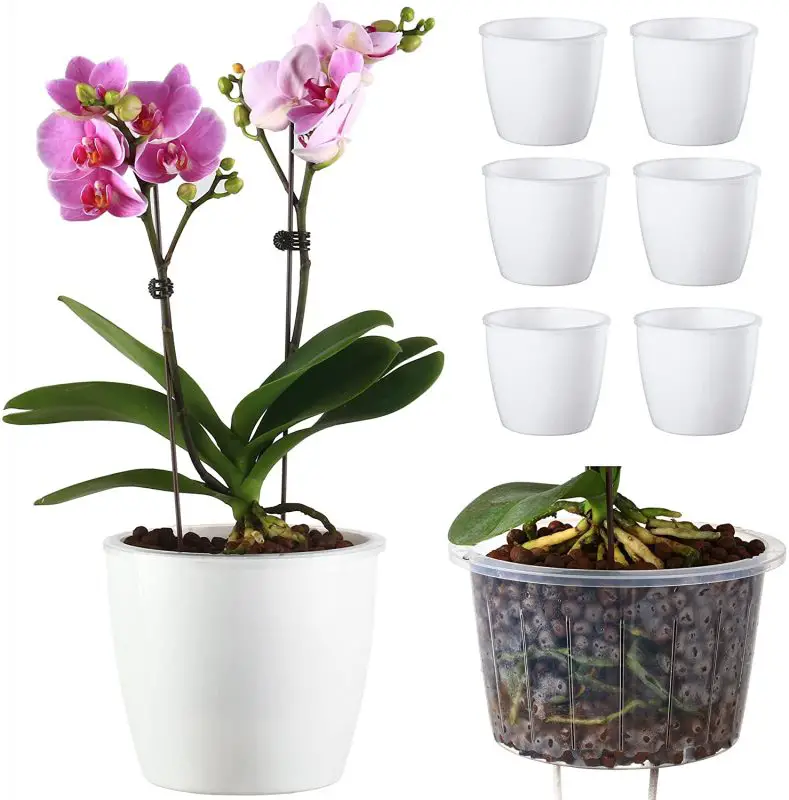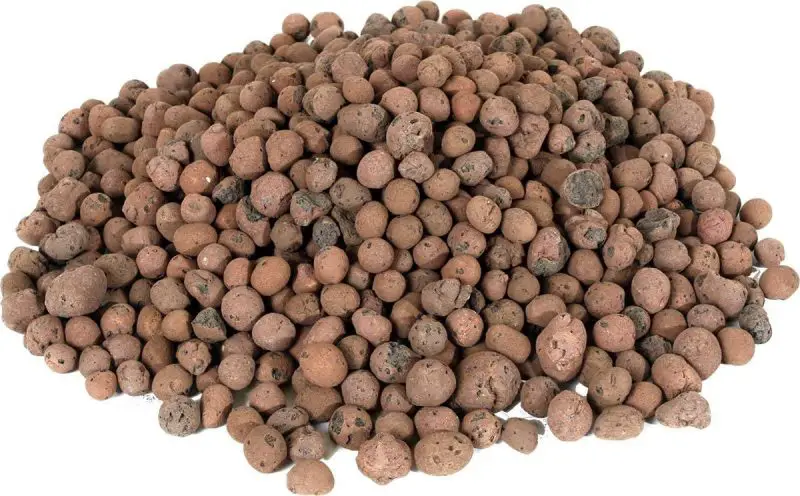If caring for orchids seems too complicated, you need to take a look at growing semi hydroponic orchids.
Using LECA pebbles and self watering planters will take the guesswork out of watering and fertilizing.
So if you want an easier way to grow orchids you have come to the right place!
Growing orchids semi hydroponically will greatly simplify growing these beautiful plants.
Why Use Semi Hydroponics?
For this method of growing, we are going to use self watering planters filled with LECA.
This will help take all the guesswork out of watering and feeding your orchids.
There are two main types of orchids: terrestrial and epiphytic.
Terrestrial orchids grow in the ground, while epiphytic orchids grow on trees or other objects.
Water culture is used mainly for epiphytic orchids and doesn’t work well for most terrestrial orchids.
But the semi hydroponic method works for all kinds of orchids.
Self Watering Planters For Semi Hydroponic Orchids
So here are the DELF Self-Watering Planters I will be using to grow my orchids.
Why Use Self Watering Planters?
I am not an expert at growing orchids at least not yet. But I do know a lot about hydroponic systems.
So I have used self watering planters to grow other crops and I know they work really well.
Actually, I prefer the term sub irrigated planter or SIP because I think it more accurately describes what these planters do and how they work.
How Self Watering Planters Grow Healthy Semi Hydroponic Orchids
The inner pot on these planters is slotted and made from clear plastic. You want a clear pot so you can see and check the health of your roots.
Inside the bottom of the inner pot is a wick. The wick ends will be set in the outer pot which will serve as your reservoir.
Water will travel up the wick and be absorbed by the LECA. So your roots will always have moisture.
But the good part is they will not have too much moisture, which can cause root rot.
So roots not only have access to oxygen because of the air spaces in the media but they also have a source of moisture too.
Using LECA In Semi Hydroponics
When it comes to semi hydroponic orchid care, the most important thing is to use the right growing medium.
LECA is an acronym that stands for Lightweight Expanded Clay Aggregate. It is also commonly known as clay pellets, hydroton, or hydro balls.
LECA is made by heating clay to a high temperature and then expanding it with steam. The resulting pellets are lightweight and full of tiny pores that make them perfect for use in semi-hydroponics.
Advantages Of Using LECA For Growing Orchids
LECA makes a great potting medium for orchids.
- It does not rot like sphagnum or bark.
- Repotting is only needed when a plant outgrows its container.
- It can be used over and over because it is not an organic medium. You can sterilize it by boiling it when you reuse it.
- It does not compact like other media and the round shape means there will be air spaces for the roots to access.
- It wicks and holds water but does not get overly wet so moisture levels stay more consistent.
- This makes it perfect for use in a self-watering planter.
Tips For Using LECA In Your Semi Hydroponic System:
- Rinse the pellets well before use. This will help remove any dust or debris that might be on the surface of the pellets.
- Thoroughly wet your LECA pellets before potting up your orchids in them.
- If you are using a wick make sure to pull it up a bit so it is surrounded by the LECA.
- Place the pellets in your pot about halfway up. Then set your plant in and fill all around the roots.
- Set your potted orchid in your grow tray or reservoir.
- You can use LECA as your sole growing medium.
- The pellets will help to wick moisture up to the roots of your plants, so they are watered automatically.
LECA is a great option for semi-hydroponic systems because it is lightweight, easy to use, and provides good drainage and aeration for the roots. Your orchids won’t need to be watered as often as plants grown in traditional potting mixes. Give it a try in your next semi-hydroponic setup!
Provide your orchids with plenty of indirect light. They also need to be kept moist, but not too wet. Semi hydroponic orchids are typically fed with a weak fertilizer solution every two weeks.
We hope that this blog post will inspire you to start growing semi hydroponic orchids of your own.
These beautiful plants are relatively easy to care for with semi-hydro and they make a great addition to any home.
What Is Semi-Hydroponics For Orchids?
Semi hydroponic orchids are those that are grown in a soilless mix and watered regularly by capillary action or wicking.
This method is growing in popularity because it is less work than traditional methods.
With semi-hydroponics, you do not have to worry about replanting your orchids as often.
Another benefit is that semi-hydroponics allows for better drainage and aeration around the roots of your plants.
This can lead to healthier plants overall.
How Do You Fertilize Orchids In Semi-Hydroponics?
With semi-hydroponic orchids, you’ll need to fertilize less often than with a traditional potting mix since the roots are constantly exposed to nutrients.
Use a balanced fertilizer formulated for orchids. Don’t apply it according to the package directions because your orchid’s roots are always exposed to nutrients.
Use it at 1/4 strength and see how your plants react. As with watering, it’s better to err on the side of too little rather than too much fertilizer.
Over-fertilizing can lead to leaf burn and other problems. Less is more with orchids or any plant.
Make sure your nutrients provide nitrate nitrogen and it’s not from a urea nitrogen source.
Don’t use organic nutrients. You want to use synthetic nutrients also called salts.
Organic nutrients will decay and cause bacteria to grow in your reservoir.
A Few Optional Nutrients For Hydroponics
These are optional and used in small amounts but they can have a dramatic effect on your plants.
Fulvic Acid is a natural chelator that enhances nutrient uptake. It is a smaller molecule than humic acid and plants can take it up through their roots.
Kelp is a natural source of many important phytohormones and micronutrients. It is also a source of potassium.
CalMag is a mix of calcium and magnesium and nitrate nitrogen. If you use distilled water or RO water you will need it.
If your plants are under LED lights they use more of this too. Many fertilizers won’t provide enough of this without supplementing.
By following these simple tips, you can successfully grow semi-hydroponic orchids.
Know Your Water’s PH
Your orchids are being fed water and nutrient soup. You need to know the starting pH of your water and the final pH after nutrients are added.
Orchids prefer a slightly acidic pH. Anywhere between 5.5 and 6.2 will work but 5.8 is considered the sweet spot for hydro.
PH will affect how available your nutrients are. Often when a plant is having problems, incorrect pH is the problem and not the nutrients themselves.
This is less of a problem with rainwater, distilled water, or RO water. But city water is often very alkaline. Mine can be 8.5 or even a bit higher.
When you add nutrients they are acidic and will lower pH but maybe not enough.
That’s why you should at least buy a pH pen but also adding a TDS meter will allow you to monitor nutrient strength too.
Flush Your Semi-Hydro Pots Regularly
Your LECA will absorb salts over time. This is especially noticeable on top where it is driest. You may even see salt crystals forming.
It is a good idea to run tepid water through the media in the inner pot. I would do it every time I need to refill the reservoir.
Salt build-up can lead to nutrient levels that are too high for your orchids or an out-of-balance nutrient profile.
So flush out the old built-up salt and start feeding with clean LECA that will absorb fresh nutrients.
Is Hydroponics Good For Orchids?
Hydroponics can be a great way to grow orchids, as long as you take care to provide the right conditions for your plants.
Semi-hydroponic orchids are especially easy to care for and can thrive in a variety of climates.
Here are a few tips on how to grow semi-hydroponic orchids:
- Choose the right potting mix. This will be LECA.
- Provide good air circulation. Semi-hydro orchids need lots of fresh air, so place your plants in an area with good airflow. A fan can help circulate the air around your plants.
- When it comes to fertilizing semi-hydroponic orchids, be sure to dilute the fertilizer before applying it to your plants.
- Apply the fertilizer every two weeks or whenever you need to refill the reservoir of your self-watering planter.
By following these tips, you can grow healthy semi-hydroponic orchids that will bloom for years to come.
Do Semi-Hydroponic Orchids Need Drainage?
Yes, semi hydroponic orchids do need drainage. Without proper drainage, the roots of your plants will sit in water and rot.
Be sure to use LECA, a well-draining potting medium. Make sure you place your plants in a container with drainage holes.
Do Semi Hydroponic Orchids Need Light?
Just like any other plant, semi hydroponic orchids need light to grow. Place your plants in an area that receives bright but indirect sunlight.
Remember these plants typically grow lower down in rain forests or on trees so they rarely get direct sunlight.
If you live in a particularly dark home, you may need to supplement the natural light with led grow lights.
Be sure to give your plants 14-16 hours of light each day for the best results.
Final Thoughts On Growing Semi Hydroponic Orchids
If you’re looking for a way to add some variety to your indoor garden, semi-hydroponic orchids are a great option.
Growing semi-hydroponic orchids is easy and they are a great way to add color and life to your home.
With just a little bit of care, you can have healthy plants that will bloom for years to come.
Read more: Growing Orchids In Hydroponics: Tips and Tricks
This post contains affiliate links.



